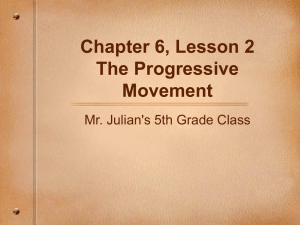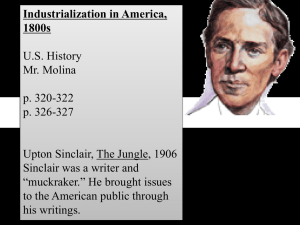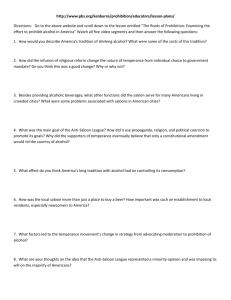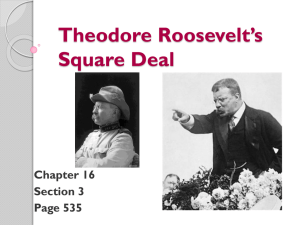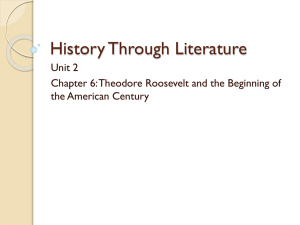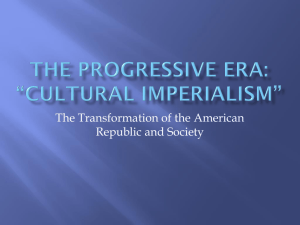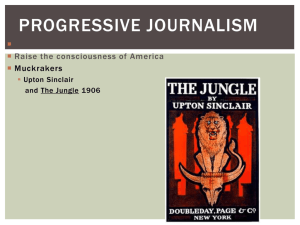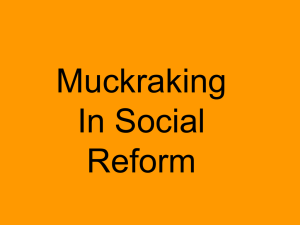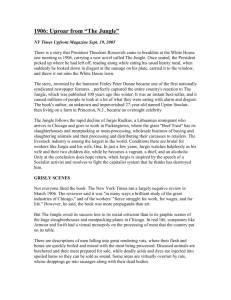week9_hn_us
advertisement
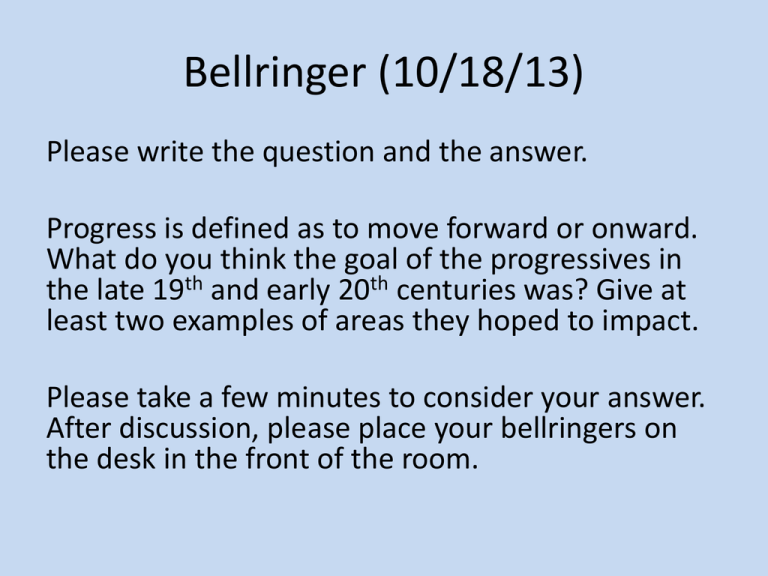
Bellringer (10/18/13) Please write the question and the answer. Progress is defined as to move forward or onward. What do you think the goal of the progressives in the late 19th and early 20th centuries was? Give at least two examples of areas they hoped to impact. Please take a few minutes to consider your answer. After discussion, please place your bellringers on the desk in the front of the room. Key Terms and People Section 1: Jacob Riis, progressivism, muckrakers, Ida Tarbell, Lincoln Steffens, Robert M. La Follette, 17th Amendment, initiative, referendum, recall Section 2: Prohibition, Woman’s Christian Temperance Union, Frances Willard, Carry Nation, 18th Amendment, National Association of Colored Women, Susan B. Anthony, National American Woman Suffrage Association Muckraking: Upton Sinclair What do you think working conditions in a meatpacking plant was like? Do you think the upper class, middle class, or working class worked in these conditions? Sinclair is famous for his novel The Jungle. It described conditions in meatpacking plants predominantly around Chicago. Reading: The Jungle Open to page 528. Quietly read the excerpt to yourself. Now, let’s read it as a class. Post-Reading: The Jungle What are some of the images created by Sinclair to convey working conditions to the reader? Do you think owners of meatpacking plants were happy with this portrayal of their businesses? How do you think the nation responded to Sinclair’s novel? Progressivism: What’s the Point? From page 522: “Progressives focused on three areas of reform: easing the suffering of the urban poor, improving unfair and dangerous working conditions, and reforming government at the national, state, and local levels.” In a small group, choose one of those three areas. Create a small poster illustrating different ways the progressives acted to improve that area, i.e. muckraking articles/books written to bring attention to the need to improve working conditions. You may use pages 522-527 in your book and/or devices. You have 30 minutes to create your poster. Happy Monday! Today will be a discussion bellringer. But first, a quick film. With a partner, discuss each of the following questions for two minutes: 1. Do you agree with the reasons progressives wanted to undertake reforming American society in the late 19th and early 20th century? 2. Do you think the progressives were successful in achieving the types of changes they wanted to? 3. Do you think there are things in American society today that mirror what the progressives were working against? Key Terms and People Section 2: Prohibition, Woman’s Christian Temperance Union, Frances Willard, Carry Nation, 18th Amendment, National Association of Colored Women, Susan B. Anthony, National American Woman Suffrage Association Temperance and Prohibtion Today we are going to watch some of the Ken Burns documentary Prohibition. While watching, 1. Think of how much alcohol was involved American society. 2. The changes in the amount of alcohol someone would drink as harder liquors were introduced. 3. What is the irony present in why men would drink and how it would effect their ability to provide for families. 4. Who were the main people spearheading prohibition and temperance movements? Why do you think this is? ON YOUR OWN: Women’s Rights Women’s roles in society changed drastically during the Progressive Era. We already learned a lot about their role in the Temperance Movement. Read through pages 530-534 to find out more about how women fought to earn a better place in America. Answer questions 2-3 on pg. 534 to the best of your ability on a sheet to turn in. You have 20 minutes. WITH A PARTNER: Ruff’N’Ready Teddy We watched a film about Theodore Roosevelt’s early life last week. With a partner, read about what happened upon his return to politics after the death of his wife and mother. a) Identify and describe the Key Terms and People from pg.535. b) Answer questions 1-3 on page 540. You have 30 minutes. One sheet per partnership. ON YOUR OWN: Taft and Wilson It was tough to follow in Teddy’s footsteps. His successor, William H. Taft, didn’t do what he wanted, and, eventually, Teddy ran again in 1912. This caused a divided Republican Party, allowing Democrat Woodrow Wilson into office. On the same sheet you used to answer about women’s rights, answer questions 1-4 on pg. 545. You have 20 minutes. WITH A PARTNER: HAWAII OR BUST Describe what each item has to do with the other. 1. 2. 3. 4. 5. 6. 7. 8. Imperialism:: Strong Navy Sanford Dole:: Hawaii Open Door Policy:: Boxer Rebellion Theodore Roosevelt:: Russo-Japanese War yellow journalism:: de Lôme Letter USS Maine:: Spanish-American War Commodore George Dewey:: Emilio Aguinaldo Philippines:: July 4, 1946 You have 30 minutes. One sheet to be turned in per partnership (You may use the one from Teddy Roosevelt activity). “Speak Softly and Carry a Big Stick” Big Stick Diplomacy (or Gunboat Diplomacy) – encourage nations in Latin America and Caribbean to do what we would like under threat of force – Help get control of “Canal Zone” in Panama when Panamanians rebelled against Colombian government – Roosevelt Corollary – Great White Fleet (1907) Roosevelt Corollary (to the Monroe Doctrine) “Chronic wrongdoing…in the Western Hemisphere…may force the United States, however reluctantly…to the exercise of an international police power.” - Theodore Roosevelt (1904)
